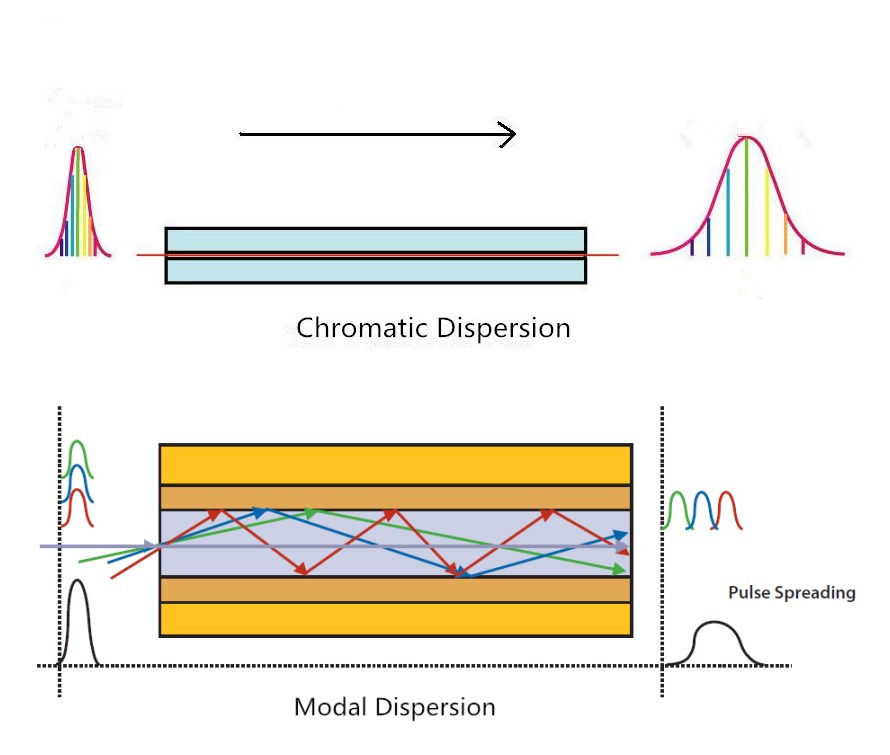Fiber-optic communication is a method of transmitting information from one place to another by sending pulses of light through an optical fiber. Compared with copper cable, fiber optic cable can support longer transmission distance, high speed, high bandwidth, etc. However, not everything is perfect. There are still some factors that may influence the transmission distance over fiber cables. This article will introduce the most common factors that limit the data transmission distance.
Generally speaking, the maximum transmission distance is limited by dispersion in fiber optic cable. There are two types of dispersion that can affect the optical transmission distance. One is chromatic dispersion, which is the spreading of the signal over time resulting from the different speeds of light rays. The other is modal dispersion representing the spreading of the signal over time resulting from the different propagation mode.
Multimode transmission is largely affected by the modal dispersion, because of the fiber imperfections, these optical signals cannot arrive simultaneously and there is a delay between the fastest and the slowest modes, which causes the dispersion and limits the performance of multimode fiber. For single-mode fiber, it is chromatic dispersion that affects the transmission distance. Because the core of the single-mode fiber optic is much smaller than that of multimode fiber. That’s the main reason why single-mode can transmit signals over longer distance than multimode fiber.

Like most of the terminals, fiber optic transceiver modules are electronic based. Transceiver modules play the role of EOE conversions (electrics-optics-electrics). The conversion of signals largely depends on an LED (light emitting diode) or a laser diode inside the transceiver, which is the light source of fiber optic transceiver. The light source can also affect the transmission distance of a fiber optic link.
LED diode based transceivers can only support short distances and low data rate transmission. Thus, they cannot satisfy the increasing demand for higher data rate and longer transmission distance. For longer transmission distance and higher data rate, laser diode is used in most of the modern transceivers, such as Cisco QSFP-40G-SR4 QSFP+ transceiver and MA-SFP-10GB-SR SFP+ transceiver. The most commonly used laser sources in transceivers are Fabry Perot (FP) laser, Distributed Feedback (DFB) laser and Vertical-Cavity Surface-Emitting (VCSEL) laser. The main characteristics of these light sources are listed below.
| Light Source | Transmission Distance | Transmission Speed | Transmission Frequency | Cost |
| LED | Short Range | Low Speed | Wide Spectral width | Low Cost |
| FP | Medium Range | High Speed | Medium Spectral Width | Moderate Cost |
| DFB | Long Range | Very High Speed | Narrow Spectral Width | High Cost |
| VCSEL | Medium Range | High Speed | Narrow Spectral Width | Low Cost |
As shown in the above chart, different laser sources support different frequencies. The maximum distance a fiber optic transmission system can support is affected by the frequency at which the fiber optic signal will be transmitted. Generally the higher the frequency, the longer distance the optical system can support. Thus, choosing the right frequency to transmit optical signals is necessary. Generally, multimode fiber system uses frequencies of 850 nm and 1300 nm, and 1300nm and 1550 nm are standard for single-mode system.
Bandwidth is another important factor that influences the transmission distance. Usually, as the bandwidth increases, the transmission distance decreases proportionally. For instance, a fiber that can support 500 MHz bandwidth at a distance of one kilometer will only be able to support 250 MHz at 2 kilometers and 100 MHz at 5 kilometers. Due to the way in which light passes through them, single-mode fiber has an inherently higher bandwidth than multimode fiber.
Splice and connector are the transmission distance decreasing reasons as well. Signal loss occurs when optical signal passes through each splice or connector. The amount of the loss depends on the types, quality and number of connectors and splices.
As a conclusion, the top 5 limiting factors in fiber optic transmission are fiber optic cable type, light source of the optics, frequency, bandwidth, splice and connector. After knowing these factors, we can take measures purposely to increase the transmission distance in real situations. Meanwhile, equipment like optical amplifiers and repeater and are also useful to support longer distance transmission.









